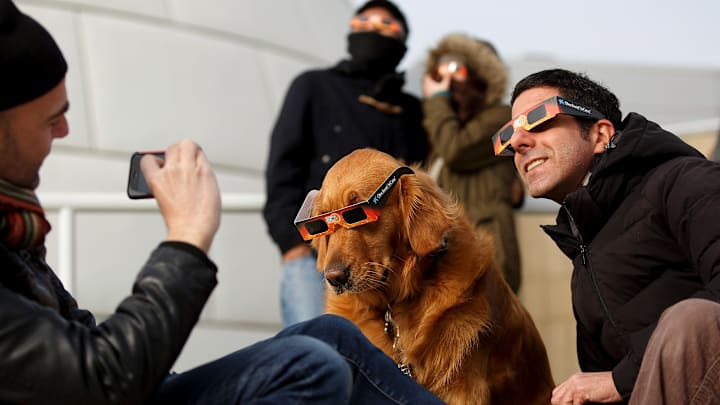Sunlight is essential for overall health. However, like anything else, too much can be harmful. Unfortunately, dogs’ eyes are also at risk of the damaging effects of UV rays. This shouldn’t stop you and your canine companion from enjoying the benefits of sunlight, though. Discover how sunlight affects your dog’s delicate eyes and how to safeguard long-term eye health.
Does sunlight affect dogs' eyes?
UV rays can be harmful to your furry friend. Prolonged exposure to sunlight can negatively impact your dog’s eye health. If you see your canine companion squinting in the sunlight, it may mean their eyes or that the sunlight is hurting them. Like in humans, UV radiation can be painful and may lead to eye diseases, such as pannus.
Also known as chronic superficial keratitis, pannus is a progressive inflammation of the cornea. A dog with this health condition may exhibit brown pigment around the eyes and a hazy cornea. Left untreated, it can lead to blindness.
Specific dog breeds, such as Greyhounds, Border collies and German shepherds, are more likely to develop this disease. A compromised immune system can also heighten the risk.
Does UV exposure only affect dogs’ eyes?
Dogs are just as susceptible as humans to sunburn. The most common areas for sunburn are the nose, ears, eyelids and tummy. Light-colored and bald dogs are more vulnerable to sunburn. The symptoms of sunburn include the following:
- Redness and inflammation: Check for red or pink skin in vulnerable areas.
- Behavioral changes: Observe signs of discomfort, such as reluctance to do any activity, restlessness or whining when touched in painful areas. Your dog may also continuously lick the affected spot.
What does your dog see?
Dogs typically have 20/75 vision, but Labradors have better eyesight closer to 20/20. They can’t distinguish the difference between blues, reds and other colors. They are also unable to see green, yellow, red and orange. So, the next time you want to play with your dog, opt for a blue-colored toy so they can easily spot it.
Knowing what your dogs can see is essential. Some mentally stimulating activities rely heavily on vision, so caring for your furry friend’s eyesight is necessary.
How to protect your dog’s eyesight
Discover strategies to safeguard your dog’s eyes.
1. Provide protective gear
According to Dr. Jessica Stine, a veterinary ophthalmologist from Florida, dog goggles are adorable accessories that can help protect eyes from injuries and UV rays. A pair of protective gear is more beneficial for breeds that are more prone to eye damage. Shih Tzus, Boston terriers, and other breeds with bulging eyes are more susceptible to cuts, abrasions and ulcers.
Rescue dogs, police dogs, and other canines that work in physically demanding environments are excellent eye protection candidates. Dog goggles can help prevent foreign substances, such as debris, punctures and other potential irritan,ts from entering their eyes.
2. Give them a proper diet
Your dog’s diet can affect their eye health and function. Provide foods rich in vitamins, minerals and antioxidants, such as eggs, fish, spinach and citrus fruits. Vitamin A is essential to prevent dry eyes. Include broccoli, carrots and red meat in your pet’s diet. Blueberries are a great source of antioxidants, phytochemicals and fiber.
Avoid foods that can worsen your dog’s eye health, such as margarine, processed meat, junk food and starchy carbohydrates. Consult with your veterinarian for a personalized diet.
3. Keep their eyes clean
Eye discharge is a common problem in dogs. Wipe their eyes clean with a moistened cotton ball to remove the eye booger. Make sure to swipe away from the eye to avoid scratching the cornea. You can also use eye drops to keep your pet’s eyes clean and moist. Some drops contain anti-bacterial and anti-fungal benefits to help fight common eye concerns, such as inflammation, abrasions, infections, ulcers, glaucoma and dry eye.
Here’s how to properly administer eye drops:
- Hold the tube in one hand, then place the other under your dog’s face to keep them still.
- Place the hand applying the eye drop on your pet’s skull to keep your hand stable.
- Using the same hand, slowly lift the affected eye’s upper eyelid.
- With the other hand, gently drag the lower eyelid of the same eye.
- Drop the medication and let the dog close their eyes.
- Be careful not to place the eye drop’s tip on your dog’s eyeball to avoid contamination.
4. Protect your dog’s eyes when giving a bath
Many shampoos and soaps contain chemicals that may irritate your dog’s eyes. Rinse a clean cloth in warm water and apply it over your furry companion’s eyes. If cloth is unavailable, use damp cotton balls. Use all-natural shampoo products to reduce your pet’s risk of eye irritation.
5. Don’t let your dog stick their head out of a car window
Many dogs poke their heads out of a moving car’s window. A dog’s nose has 300 million smell receptors, and sticking out their head means indulging in various scents they encounter. It could be the cutest thing ever, but unfortunately, it can harm their eyes. The rush of wind can trigger dry eyes. It also puts their eyes at risk of damage from debris and insects.
However, this doesn’t mean you should always keep your windows closed. Just ensure it’s only opened far enough to allow fresh air to circulate and prevent your dog from poking out their head.
Protect your dog’s eyes from the sun
Sunlight can harm your dog’s eyes when exposed for long periods. Recognizing the signs of sun-related eye concerns, providing protective eyewear and keeping eyes clean can significantly reduce the likelihood of vision problems.
